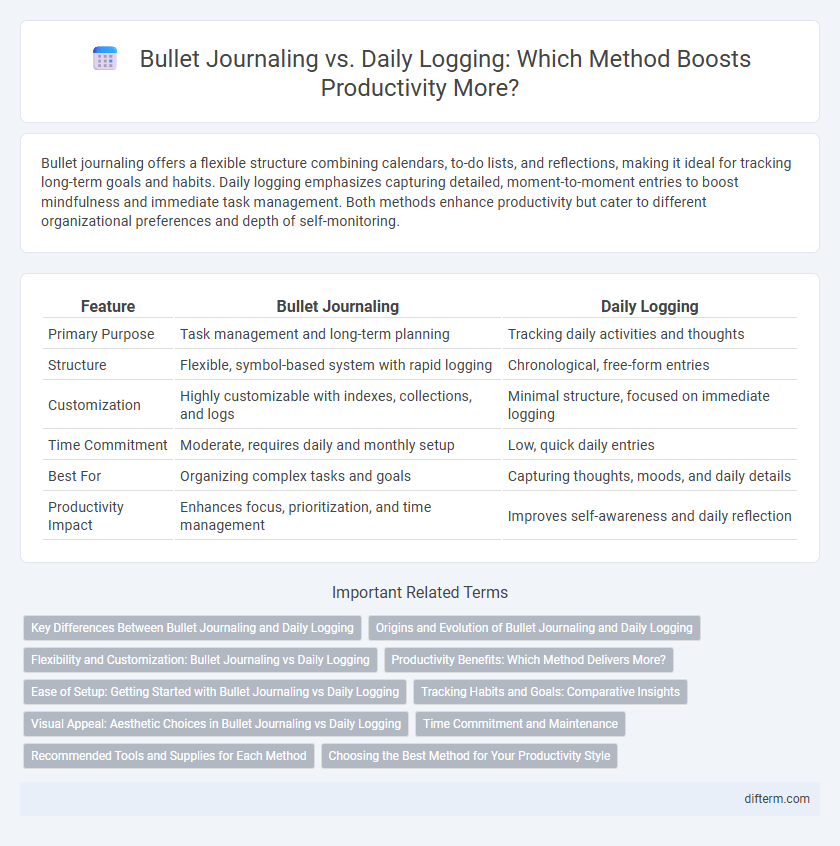Bullet journaling offers a flexible structure combining calendars, to-do lists, and reflections, making it ideal for tracking long-term goals and habits. Daily logging emphasizes capturing detailed, moment-to-moment entries to boost mindfulness and immediate task management. Both methods enhance productivity but cater to different organizational preferences and depth of self-monitoring.
Table of Comparison
| Feature | Bullet Journaling | Daily Logging |
|---|---|---|
| Primary Purpose | Task management and long-term planning | Tracking daily activities and thoughts |
| Structure | Flexible, symbol-based system with rapid logging | Chronological, free-form entries |
| Customization | Highly customizable with indexes, collections, and logs | Minimal structure, focused on immediate logging |
| Time Commitment | Moderate, requires daily and monthly setup | Low, quick daily entries |
| Best For | Organizing complex tasks and goals | Capturing thoughts, moods, and daily details |
| Productivity Impact | Enhances focus, prioritization, and time management | Improves self-awareness and daily reflection |
Key Differences Between Bullet Journaling and Daily Logging
Bullet journaling combines task management, calendars, and notes in a customizable system emphasizing rapid logging with symbols for tasks, events, and notes, while daily logging focuses on recording detailed, date-specific entries for tracking activities and thoughts. Bullet journaling uses modules like future logs, monthly spreads, and collections to organize long-term goals and projects, whereas daily logging centers on capturing day-to-day details with timestamps and chronological order. The primary distinction lies in bullet journaling's flexibility and symbolic shorthand versus daily logging's structured, narrative-style record keeping.
Origins and Evolution of Bullet Journaling and Daily Logging
Bullet journaling originated in 2013 by Ryder Carroll as a customizable analog system combining task management, calendars, and journaling to enhance productivity and mindfulness. Daily logging, a traditional method for capturing day-to-day tasks and reflections, has evolved from basic diary forms to digital notes and apps, focusing primarily on chronological task tracking. Both methods have adapted over time to integrate technology and modern productivity principles, offering varied approaches for organizing time and priorities.
Flexibility and Customization: Bullet Journaling vs Daily Logging
Bullet journaling offers unparalleled flexibility and customization, allowing users to design their layouts, incorporate various trackers, and adapt formats to personal productivity goals. Daily logging, while more structured, provides consistent and straightforward entries that can be tailored with minimal modifications to fit individual needs. Both methods support productivity but bullet journaling excels in creative adaptability, whereas daily logging emphasizes simplicity and routine.
Productivity Benefits: Which Method Delivers More?
Bullet journaling offers enhanced productivity benefits through its customizable structure that combines task management, goal setting, and reflection in one system, promoting better organization and focus. Daily logging, while simpler and quicker, excels in tracking routine activities and immediate tasks, improving time awareness but lacking the integrative planning features of bullet journaling. Studies show bullet journaling users report higher task completion rates and improved long-term goal achievement compared to daily logging practitioners.
Ease of Setup: Getting Started with Bullet Journaling vs Daily Logging
Bullet journaling requires an initial setup involving index creation, key symbols, and future logs, which can be time-consuming but offers structured customization. Daily logging, on the other hand, involves jotting down tasks and events directly without elaborate preparation, making it quicker to begin for immediate use. Ease of setup favors daily logging for fast implementation, while bullet journaling suits users seeking a personalized, flexible system.
Tracking Habits and Goals: Comparative Insights
Bullet journaling offers a customizable framework for tracking habits and goals, allowing users to design personalized spreads that align with their productivity objectives. Daily logging in contrast emphasizes simple, chronological recording of tasks and achievements, promoting real-time accountability and reflection. Both methods enhance habit tracking effectiveness, but bullet journaling provides greater flexibility for goal visualization and progress monitoring.
Visual Appeal: Aesthetic Choices in Bullet Journaling vs Daily Logging
Bullet journaling offers extensive aesthetic customization with hand-drawn layouts, colorful markers, and creative fonts to enhance visual appeal, encouraging user engagement and motivation. Daily logging tends to prioritize simplicity and efficiency, using straightforward lists and minimal decoration to maintain clarity and quick reference. The choice between the two depends on whether visual inspiration or rapid usability is the primary productivity goal.
Time Commitment and Maintenance
Bullet journaling demands a higher initial time commitment due to its customizable layouts and artistic elements, requiring consistent daily updates to maintain organization. Daily logging offers a streamlined approach with quicker entries focused on task and event tracking, minimizing maintenance time while still promoting productivity. Choosing between the two depends on balancing detailed personalization with efficient time use for sustainable productivity habits.
Recommended Tools and Supplies for Each Method
Bullet journaling often requires a dotted or grid notebook, fine-tip pens, and a ruler to create structured layouts and trackers that enhance productivity. Daily logging benefits from a simple lined or blank notebook paired with a reliable pen for quick entries and reflections to maintain consistency. Both methods may use highlighters, stickers, and washi tape to add color-coding and personalization, but bullet journaling typically demands more diverse tools for intricate organization.
Choosing the Best Method for Your Productivity Style
Bullet journaling offers a flexible, creative approach to organizing tasks, allowing users to customize layouts and integrate goal-setting elements. Daily logging emphasizes simplicity and efficiency by capturing tasks and events in a straightforward, chronological order, ideal for those who prioritize quick entries and reflection. Selecting the best method depends on your productivity style: choose bullet journaling for in-depth planning and visual tracking, or daily logging for minimalist task management and rapid note-taking.
bullet journaling vs daily logging Infographic

 difterm.com
difterm.com